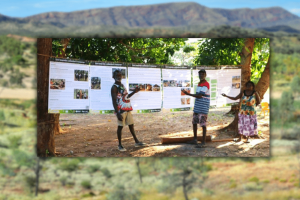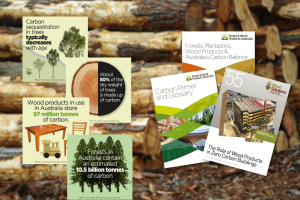The results of a recently completed, FWPA-supported collaborative research project have demonstrated the potential of using dense, 3D point cloud data to link tree and plot-level measurements in native forests, gathered using a mobile laser scanner (MLS), alongside airborne laser scanning (ALS) data.
A ‘point cloud’ is a collection of tiny individual points plotted in 3D, made up of a multitude of points captured using a 3D laser scanner.
The result? A more accurate, repeatable, safe, and accessible means of a gaining a complete picture of native forest structure and condition, to inform better decision making amongst forest managers.
Laser scanning native forests
Over the last two decades, the need for effective plantation forest resource management has been one of the main driving forces behind the adoption of ALS and MLS by industry.
However, less attention has been given to the use of these technologies in Australian native forests. Increasing recognition of the importance of native forests in providing ecological and social ecosystem services, in addition to economic benefits through timber harvest, has led to increased demand for quantitative information on their condition and ecological status, from industry and beyond.
Successful sustainable management of our native forests requires detailed information on forest structural diversity and composition, to gain an accurate sense of the arrangement and distribution of the vegetation elements within them. Therefore, the timely gathering of relevant metrics is a key component of monitoring, reporting and evaluation activities undertaken by forest managers. A collaborative 12-month scoping study was recently undertaken, led by Dr Christine Stone and Dr Sam Hislop of the New South Wales Department of Primary Industries, in response to the increased demand from forest managers for effective ways to monitor and report on factors relating to the structure and composition of native forests.
Advanced technologies
The vast areas covered by Australian native forests present the need to implement multi-source methods that link traditionally gathered terrestrial tree and plot-level measurements collected through terrestrial laser scanning (TLS), alongside additional data acquired through modern terrestrial, airborne and satellite technologies.
The concept of an integrated, multi-source, multi-scale framework for monitoring large areas of native forest is fast becoming a reality through the adoption of rapidly advancing remote sensing technologies such as LiDAR (Light (laser) Detection and Ranging). These advanced laser scanners acquire accurate and precise 3D point cloud data from terrestrial scanners, drones, aircraft and even satellites.
MLS and ALS data
Key to this research was a thorough evaluation of the capacity of MLS and ALS data to provide quantified information with respect to characterising the complex vertical and horizontal spatial structures of eucalypt forests. Six plots in north-eastern NSW were selected and measured. All the study plots were characterised as having complex dense understorey vegetation, as well as a mature eucalypt overstorey.
Opportunities around the potential for the integration of ALS data with plot-level, sub-canopy MLS data has so far received limited attention. The research team therefore set out to investigate whether the fusion of data acquired through ALS and MLS could help meet the assessment needs of native forest managers.
LiDAR data acquired by aircraft (ALS) can cover forests at the estate-level and provides information relating to the vertical and horizontal structure of the overall canopy and largest trees (i.e., as seen from above). In addition to being used for traditional inventory metrics, ALS data can also be used to derive a suite of more complex structural stand metrics that can be used for habitat suitability models, canopy change detection, above ground biomass estimates, wildfire modelling and fuel load estimation.
However, ALS has limitations around measuring parameters such as diameter at breast height (DBH) because of the position of the sensor above the canopy. MLS technologies, on the other hand, can operate below the canopy and are receiving considerable attention as an alternative approach to manual field data collection.
A detailed comparison of ALS and MLS data was conducted, to create a better understanding of the commonalities and differences in how effectively these types of data represent a realistic picture of forest structure. While both systems rely on LiDAR technology, the different position of the sensor in relation to the forest canopy leads to different outputs. Understanding the strengths and weaknesses of these remote sensing systems is therefore essential to form accurate conclusions about forest structure.
Making data more complete
During this research, comparisons were made between metrics derived from the Hovermap (Emesent)-acquired MLS data, and data gathered using manual collection techniques employed on-the-ground by field crew. While measurements of tree density, stem diameter and tree height can reliably be obtained through such traditional practices, estimates of plot level structural attributes such as understorey density and cover, have often proved inaccurate, imprecise, and time-consuming.
Despite the challenging nature of the forest plots studied, the results demonstrated how using both MLS and ALS technologies can lead to a more complete and accurate characterisation than traditional field assessment approaches for many plot-level structural attributes. Comparison of the ALS and MLS data showed these datasets to be complimentary, due to one system operating from above and the other from below.
While both LiDAR datasets produced very similar canopy height models, errors relating to stem counts, particularly for smaller diameter trees, were observed. However, when tree attributes manually detected using the Hovermap data were matched with individual tree attributes acquired from field data, close correspondence between tree height and DBH was achieved.
Crown, overstory, sub-canopy
This study also presented a significant improvement in the automated detection of individual tree attributes using MLS, through a novel approach that involved the initial classification of tree crowns as overstorey, sub-canopy crowns, standing stag or dead-top trees. A tree detection and segmentation algorithm workflow was applied, resulting in significantly improved tree crown delineation, and estimates of tree heights and DBH.
Although challenges remain with respect to the fusion of different LiDAR data sources, the researchers demonstrated numerous applications and approaches to improve the structural description of subcanopy vegetation by integrating ALS and MLS data.
In the context of forest monitoring, MLS can be considered a sampling tool, used to enhance the efficiency and accuracy of field measurements. The derived metrics could then be used for spatial modelling to improve traditional inventory metrics, or be incorporated into biomass, habitat, or wildfire risk modelling alongside ALS data.
Where to next?
The next stage in developing a multi-source monitoring framework is the integration of airborne data acquired by spaceborne sensors that cover large areas. An example of spaceborne LiDAR is the Global Ecosystem Dynamics Investigation (GEDI) instrument onboard the International Space Station, which has been collecting data since April 2019.
GEDI is designed to provide high-resolution observations of forest vertical structure, and currently its data is being used to create a suite of vegetation structure and biomass products, including vegetation height and cover.
The research team now recommends a further study, with a view to comparing TLS and Hovermap datasets captured within the same plots, to provide greater insight into the accuracy of Hovermap data.
This additional information would improve the recommendations provided for optimising the quality and precision of tree-level and plot-level metrics extracted from the MLS and ALS data, which would benefit native forest managers in their decision making.



